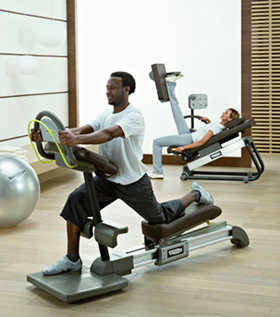
Yoga Time!
[media id=17 width=500 height=400]
Yoga (Sanskrit, ) refers to traditional physical and mental disciplines originating in India. The word is associated with meditative practices in Hinduism, Buddhism and Jainism.In Hinduism, it also refers to one of the six orthodox (āstika) schools of Hindu philosophy, and to the goal toward which that school directs its practices.In Jainism it refers to the sum total of all activities—mental, verbal and physical.
History of yoga
The Vedic Samhitas contain references to ascetics, while ascetic practices (tapas) are referenced in the Brāhmaṇas early commentaries on the Vedas. Several seals discovered at Indus Valley Civilization) sites depict figures in positions resembling a common yoga or meditation pose, showing “a form of ritual discipline, suggesting a precursor of yoga”, according to archaeologist Gregory Possehl.Some type of connection between the Indus Valley seals and later yoga and meditation practices is speculated upon by many scholars, though there is no conclusive evidence.
Techniques for experiencing higher states of consciousness in meditation were developed by the shramanic traditions and in the Upanishadic tradition.
While there is no clear evidence for meditation in pre-Buddhist early Brahminic texts, Wynne argues that formless meditation originated in the Brahminic tradition, based on strong parallels between Upanishadic cosmological statements and the meditative goals of the two teachers of the Buddha as recorded in the early Buddhist texts. He mentions less likely possibilities as well. Having argued that the cosmological statements in the Upanishads also reflect a contemplative tradition, he argues that the Nasadiya Sukta contains evidence for a contemplative tradition, even as early as the late Rg Vedic period.
Islam
The development of Sufism was considerably influenced by Indian yogic practises, where they adapted both physical postures (asanas) and breath control (pranayama).The ancient Indian yogic text, Amritakunda, (“Pool of Nectar)” was translated into Arabic and Persian as early as the 11th century.
Malaysia’s top Islamic body in 2008 passed a fatwa, which is legally non-binding, against Muslims practicing yoga, saying it had elements of “Hindu spiritual teachings” and could lead to blasphemy and is therefore haraam. Muslim yoga teachers in Malaysia criticized the decision as “insulting”. Sisters in Islam, a women’s rights group in Malaysia, also expressed disappointment and said they would continue with their yoga classes.The fatwa states that yoga practiced only as physical exercise is permissible, but prohibits the chanting of religious mantras, and states that teachings such as uniting of a human with God is not consistent with Islamic philosophy. In a similar vein, the Council of Ulemas, an Islamic body in Indonesia, passed a fatwa banning yoga on the grounds that it contains “Hindu elements” These fatwas have, in turn, been criticized by Darul Uloom Deoband, a Deobandi Islamic seminary in India.
In May of 2009, Turkey’s head of the Directorate of Religious Affairs, Ali Bardakoğlu, discounted Yoga as a commercial venture promoting extremism- comments made in the context of Yoga practice possibly competing with and eroding participation in Islam
Christianity
In 1989, the Vatican declared that Eastern meditation practices such as Zen and yoga can “degenerate into a cult of the body.” Despite the Vatican statement, many Roman Catholics bring elements of Yoga, Buddhism, and Hinduism into their spiritual practices.
Tantra
Tantrism is a practice that is supposed to alter the relation of its practitioners to the ordinary social, religious, and logical reality in which they live. Through Tantric practice an individual perceives reality as maya, illusion, and the individual achieves liberation from it. This particular path to salvation among the several offered by Hinduism, links Tantrism to those practices of Indian religions, such as yoga, meditation, and social renunciation, which are based on temporary or permanent withdrawal from social relationships and modes
During tantric practices and studies, the student is instructed further in meditation technique, particularly chakra meditation. This is often in a limited form in comparison with the way this kind of meditation is known and used by Tantric practitioners and yogis elsewhere, but is more elaborate than the initiate’s previous meditation. It is considered to be a kind of Kundalini Yoga for the purpose of moving the Goddess into the chakra located in the “heart,” for meditation and worship.
Yoga , Yoga Health, Yoga Health Latest, Yoga Health Information, bealthy breakfast Health information, Yoga Health Photo, Yoga Health Latest, Yoga Health latest, Yoga Health Story, Yoga Health story, Yoga Video, Yoga video, Yoga Health History, Yoga Health history, history, Yoga Asia, Yoga asia, Yoga Gallery, Yoga gallery, Yoga Photo Gallery, Yoga photo gallery, Yoga Picture, Yoga picture, Yoga Web, Malaysia Health, web Health, picture, video photo, gallery, laparoscopy, virus, flu, drug, video, photo, nutrition, symptoms, surgery, operation, bf1, hotforwords, hot, for, words, intelligence, is, marina, orlova, word , origins, etymology, fight, or, flight, neuro, bliss, neurobrands




